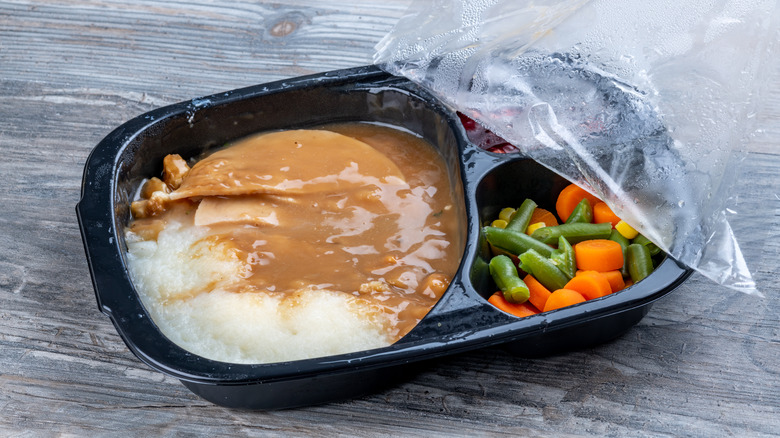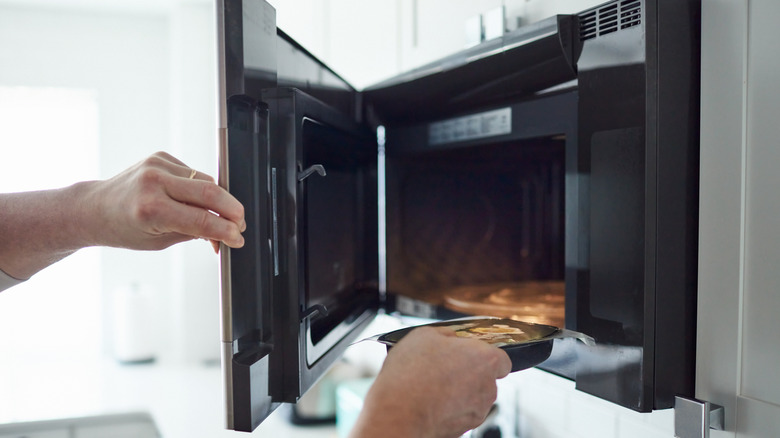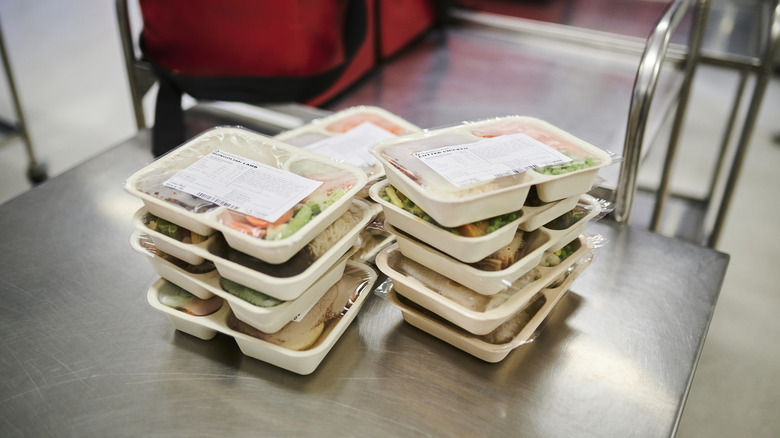Why TV Dinners Fell Out Of Popularity
What could be more evocative of the 1950s than a good old-fashioned TV dinner? These pinnacles of innovation were built on years of technological advances, starting with the TV itself. According to data from the U.S. Census Bureau, between 1950 and 1955, the percentage of American households owning TVs jumped from 9% to over 64%. Americans wanted to spend more time watching their favorite shows and less time in the kitchen, especially as women increasingly left homemaking to enter the workforce.
The technology for TV dinners began in the 1940s as frozen airplane meals, which could be reheated onboard during long flights. However, the most popular story about how these meals came to the average home begins in 1953, when the Swanson company invented the commercial TV dinner — out of necessity. Stuck with over 200 tons of unsold frozen Thanksgiving turkey, the company decided to offload its surplus by selling pre-packaged meals with sides to accompany the seemingly unending poultry supply. Now, instead of spending hours cooking and cleaning, meals were designed to be heated and ready to go in the oven for roughly 30 minutes.
TV dinners spurred an entire industry of frozen food that dominated American grocery shopping through the 1970s. But its reign, alas, was not meant to last. The technological innovations that defined TV dinners would also lead to their downfall, as frozen food giants learned that convenience is not always as much of a bonus as it might seem — especially when it comes to nutrition.
The microwave backlash
Originally sold in aluminum trays, TV dinners were overhauled in the 1980s to become near-instant microwaveable meals in plastic containers. Despite the convenience of this update, many diners gradually became concerned about the nutritional value of these ultra-easy meals. The public developed a perception that microwaved TV dinners were lacking in essential nutrients and were highly processed, full of saturated fats and sodium.
A TV dinner cooked in the oven might at least retain the appearance of something home-cooked, but plastic-packed dinners that could be heated in mere minutes strayed too far from the original concept. The final nail in the coffin may have been the myriad studies released in the early 2000s, revealing that microwave-safe plastic isn't exactly safe for the people eating out of it, making microwaveable meals even less appealing to a health-conscious public.
TV dinners experienced a drop-off in popularity after that, with sales plateauing through the early 2000s. The late '90s through the early 2000s saw the peak of the farm-to-table movement and increased interest from American consumers in the origins of their food. Consumers no longer wanted questionable frozen food cooked and packaged in a facility thousands of miles away; those who could afford it wanted to eat fresh and local. Fast food chains began to see competition from fast-casual spots like Sweetgreen (opened in 2007), which emphasized customizable dishes made in front of the consumer, instead of cookie-cutter factory meals.
A new era of TV dinners
TV dinners may have seen their last microwave decades ago, but something unexpected occurred in 2020: the COVID-19 pandemic, which caused frozen food sales to skyrocket as customers tried to stock up on as much food as possible in one grocery store visit. An already blossoming grocery delivery industry further expanded with frozen food, which travels well without spoiling — a major component of these companies' offerings.
As such, TV dinners have been reworked and rebranded for this new era, making high-quality instant Asian food trendy, and turning Trader Joe's into frozen food royalty. Instead of the sectioned-out meals of the 1950s, one-bowl dishes like pad thai and butter chicken have taken over, reflecting modern tastes and a global culinary influence. Many Americans still eat in front of their TVs — or, more likely, their TVs, laptops, and iPhones — making the efficiency of frozen meals as relevant now as it ever was. To put it simply, while the microwaveable TV dinner may be dead, long live the instant Netflix dinner.



